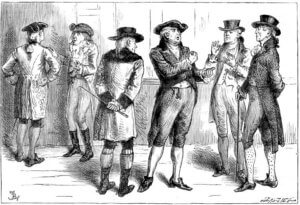
The American economist and sociologist Thorstein Veblen (1857 – 1929) is best known for his book the Theory of the Leisure Class which analysed social class divisions and consumerist culture in 19th century America. Although Veblen wrote this work over a century ago, his analysis remains pertinent to understanding our consumerist culture in the West today. In particular, his theory of “conspicuous consumption” offers a convincing account of the social forces propelling our ever-increasing demand for material goods, property and wealth. Indeed, it may only be in this century, when the environmental impacts of our consumerist lifestyles are being laid bare, that Veblen’s work will get the attention and recognition it deserves. For if we truly wish to redefine our relationship with the natural world and avert the impending ecological catastrophe, what better place to start than by identifying and recognising the forces driving our wasteful consumption?
The Roots of our Modern Consumerist Society
To understand the origins of our modern consumerist society, Veblen takes us on a historical journey through what he sees as the four major phases of human societal development, starting with the primitive hunter-gatherer societies that were built on familial and tribal ties. According to Veblen, these early human societies were mainly peaceable in nature; they lived in harmony with the environment, subsisting on fruits and vegetables and the hunting of small animals. Private property, he asserts, was not a dominant feature of their social life. Rather, possessions tended to be owned communally by the tribe. And there was no consistent or rigorous distinction between the types of work performed by different tribe members nor any clear differentiation on the basis of social class.

With population growth, Veblen argues that this relatively peaceable way of life gave way to a barbarian phase of society in which there was greater competition for resources. Here, humans were more commonly engaged in warfare with rival, neighbouring tribes and were forced to hunt large game for their subsistence. This change in circumstances prompted a more rigorous distinction between the types of work that different tribe members performed. Men – whose physical stature, muscular force and temperament meant they were more capable of violence – tended to become involved in predatory activities such as hunting and warring. While women tended to work on the shaping of natural materials to produce goods that could further the tribe’s way of life. With the passage of time, Veblen argues that the predatory exploits of the male tribe members came to be associated with honour and dignity, while the drudgery of women’s manual labour led to their work being viewed as unworthy and debasing.
During this barbarian phase, the notion of private property also began to emerge. According to Veblen, this arose as a result of the booty collected during successful raids on rival tribes. At first, this booty was held communally as a collective marker of the tribe’s success. However, this dynamic changed with the seizure of female captives, an activity which gave rise to marriage as a form of ownership of women. Veblen argues that the concept of ownership then gradually extended to include the products of these women’s industry – the goods they made out of natural materials. And whereas before, these possessions would have been valued collectively as evidence of a successful raid, they increasingly became viewed as evidence of the superior effectiveness of their male possessor over other males in the same tribal community. From this point onwards – as the concept of private property became more fully established – Veblen observes that men were increasingly engaged in a struggle over the possession of material goods in an effort to assert their authority over their fellow man.

This struggle for social status and recognition took on a new form during Veblen’s third phase of societal development: the “quasi-peaceable industrial” era. This era was marked by an increase in industrial activity, and a gradual reduction in the predatory activities of hunting and warring. Technological innovations in agriculture and farming also meant that a portion of the community could become exempt from routine manual labour, resulting in the formation of a new “leisure class”. This mainly consisted of nobles, aristocrats and priests who were solely engaged in activities to which a degree of honour attached, such as government, warfare, priestly service and sports. According to Veblen, these “honourable” activities were simply an outgrowth of the predatory work that men were engaged in during the barbarian phase of society. Meanwhile, manual labour and the everyday work of getting a livelihood became the exclusive occupation of an inferior class – an extension of the undignified manual work of the woman in the earlier barbarian phase.
It is during this quasi-peaceable industrial era that Veblen’s famous theories of “conspicuous leisure” and “conspicuous consumption” come to the fore. As the opportunities for men to gain distinction through warfare and aggression became less frequent, Veblen argues that the conventional measure of success within society came to be associated with an abstention from manual labour (which was seen as debasing) and an accumulation of property and wealth (which was seen as honorific). Just as in the earlier barbarian phase it was necessary for men to come up to their tribe’s standard of physical endurance and skill at warfare, in this new industrial era it was necessary for men to come up to a certain conventional standard of wealth and property in order to have a good standing in their community. Anything in excess of this standard conferred even greater merit and honour to the individuals in question.
As Veblen explains, it was not enough for men to simply accumulate wealth and abstain from work. They also had to evidence this to their peers. The upper classes therefore engaged in conspicuous displays of leisure and consumption to maintain their reputable standing within the community. These displays included showing off their artistic and scholarly accomplishments – their knowledge of dead languages, of music and art, the proprieties of dress and furniture, manners and decorum – knowledge that could not be achieved if their time and energy was taken up with daily manual labour. They also engaged in extravagant displays of consumption of non-essential, luxury goods – the best in food, drink, narcotics, shelter, services, ornaments, clothing, weapons, and entertainments – to indicate their wealth and social status. The wives of noblemen also became exempt from industrial labour as a marker of their husband’s ability to keep them in a life of leisure. These women were, however, still expected to show painstaking attention to the master of the house and the maintenance of his household. Their role was to uphold their husband’s conspicuous consumption in order to serve his reputation in the community.

As the industrial era gave way to today’s modern society, Veblen notes that the upper-class abstention from labour curiously went out of mode. However, whereas in the earlier industrial phase, conspicuous consumption was purely an activity of the upper “leisure class”, in the modern era this restriction has completely disappeared. Conspicuous consumption is now to be found at every level of society. As Veblen explains, this is partly due to the tendency of members of each social class to emulate the scheme of life that is fashionable in the class above them. Therefore, as the overall wealth of society has increased, the lower social classes have used their improved spending power to simply imitate the consumption practices of the upper “leisure class”. The resulting dynamic is one in which individuals at every level of society are locked in a competitive struggle to excel everyone else around them in the consumption of goods – to have a bigger house, a better car, more fashionable clothes, more exotic holidays than their neighbours and peers.
It is this basic human struggle for social status and recognition that, Veblen argues, is the driving force behind our consumerist society. And he warns that this way of life is coming at a huge cost to our natural environment and wellbeing. Our daily consumption of “non-essential” goods is accelerating the depletion of our planet’s natural resources, while the constant need to compare our possessions with those of our peers and neighbours is drawing us into a life of “chronic dissatisfaction”. For no matter how much material wealth we each accumulate, there will always be someone else – another person to compare ourselves with – whose lifestyle is out of our reach:
“The end sought by accumulation is to rank high in comparison with the rest of the community in point of pecuniary strength. So long as the comparison is distinctly unfavourable to himself, the normal, average individual will live in chronic dissatisfaction with his present lot; and when he has reached what may be called the normal pecuniary standard of the community, or of his class in the community, this chronic dissatisfaction will give place to a restless straining to place a wider and ever-widening pecuniary interval between himself and this average standard. The invidious comparison can never become so favourable to the individual making it that he would not gladly rate himself still higher relative to his competitors in the struggle for pecuniary reputability”. 1
By revealing the forces that are driving our insatiable appetites for material wealth – and the detrimental effects these have on our own happiness and the natural environment – Thorstein Veblen forces us to confront some very difficult questions about our prevailing way of life.
Further Resources
Thorstein Veblen’s The Theory of the Leisure Class is a fascinating book that challenges us to reflect upon the motivations that underpin our consumer spending. It is essential reading for anyone with an interest in environmental issues, who wishes to understand the social dynamics influencing our wasteful consumption.
While Veblen is not a household name, his work has had a significant influence on many other prominent sociologists and economists, most notably the French sociologist Pierre Bourdieu. Bourdieu built upon Veblen’s notions of pecuniary emulation and conspicuous consumption in his work on the reproduction of social class, which is discussed in further detail here.
To complement your reading of Veblen’s work, additional video resources can be found on our Mind Attic YouTube channel playlist.


